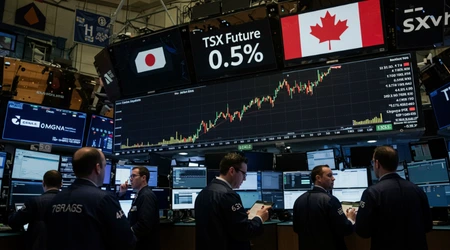TSX Futures Jump 0.5% as U.S.–Japan Trade Deal Ushers in Market Optimism

TSX Futures Jump 0.5% as U.S.–Japan Trade Deal Ushers in a wave of market enthusiasm, signaling brighter days for Canadian investors.
On July 23, 2025, news broke of a landmark U.S.-Japan trade agreement, slashing tariffs on Japanese exports to 15% and unlocking $550 billion in Japanese investments into the U.S. economy.
This deal, announced by President Donald Trump, sparked a global rally, with Canada’s S&P/TSX index futures climbing 0.5% in early trading. Why does this matter?
For Canada, a nation deeply intertwined with global trade, this development hints at easing tariff tensions, potentially stabilizing markets rattled by months of uncertainty.
This article dives into the implications of the U.S.-Japan deal for Canadian markets, exploring sector-specific impacts, investor sentiment, and what lies ahead.
The ripple effects of this agreement extend beyond Wall Street and Tokyo’s Nikkei, which soared 3.51% to 41,171.32. Canada’s economy, heavily reliant on exports to the U.S., stands to benefit indirectly from reduced global trade friction.
Investors are now eyeing opportunities in sectors like energy and financials, which have shown resilience amid recent volatility.
With the August 1 tariff deadline looming, the deal fuels hope for further negotiations, potentially with the EU and Canada itself. But is this optimism sustainable, or are we riding a fleeting wave?
Let’s unpack the dynamics driving this market surge and what it means for Canadian investors.
A Beacon of Stability in a Turbulent Trade Landscape
Global markets have been on edge since Trump’s April 2025 tariff announcements targeting major trading partners, including Canada. The TSX Futures Jump 0.5% as U.S.–Japan Trade Deal Ushers in a sigh of relief, as the agreement signals a potential de-escalation.
Japan’s deal, which includes a 15% tariff on auto exports in exchange for massive investments, sets a precedent for compromise.
For Canada, this could mean a template for future U.S. negotiations, especially critical given the 25% tariffs still imposed on Canadian auto exports.
The Bank of Canada warned in May 2025 that a prolonged trade war could destabilize financial institutions and increase household debt burdens.
++ Tariff Resilience: How Canada Is Turning U.S. Trade Tensions Into a ‘Buy Canadian’ Movement
This deal offers a counterpoint, suggesting a path toward stability. Canadian investors, wary of tariff-driven inflation, see the TSX Futures Jump 0.5% as U.S.–Japan Trade Deal Ushers as a sign that markets may avoid the worst-case scenario.
Yet, caution remains, as details of the Japan deal are sparse, and Canada’s own trade talks are ongoing.
For example, consider a Toronto-based auto parts manufacturer like Magna International. If U.S. tariffs on Canadian autos ease, Magna could see a surge in demand, boosting its stock.
Conversely, prolonged uncertainty could keep investors on edge. The deal’s success hinges on whether other nations, including Canada, can secure similar terms before August 1.

Sector Spotlight: Energy and Financials Lead the Charge
Energy stocks, a cornerstone of the TSX, gained 0.54% on July 23, 2025, driven by optimism from the U.S.-Japan deal. The TSX Futures Jump 0.5% as U.S.–Japan Trade Deal Ushers in confidence that global demand for Canadian oil could stabilize.
With Brent crude at $68.50 per barrel, energy firms like Cenovus Energy stand to benefit from any uptick in U.S. demand. However, falling gold prices, down 1.25% to $3,388.60 an ounce, dragged the materials sector lower.
Financials, another TSX heavyweight, rose 0.7% as investors bet on reduced economic uncertainty. Banks like RBC and TD, sensitive to trade disruptions, could see improved lending conditions if tariffs ease.
The TSX Futures Jump 0.5% as U.S.–Japan Trade Deal Ushers reflects this renewed faith in financial stability. Still, the materials sector’s 1.3% drop highlights uneven impacts across industries.
Also read: Canadian Dollar Strengthens on Global Trade Optimism: What It Means for Canadians
Picture a Canadian investor reallocating their portfolio. They might double down on energy stocks like Suncor, expecting steady oil demand, while trimming exposure to gold miners like Barrick Gold.
This strategic shift mirrors broader market trends, where sector rotation is driven by trade news. The challenge lies in timing these moves, as tariff deadlines could shift market dynamics overnight.
Investor Sentiment: Riding the Wave or Bracing for Impact?
The TSX Futures Jump 0.5% as U.S.–Japan Trade Deal Ushers in a cautious optimism among Canadian investors, but sentiment remains mixed. A Reuters report from July 23, 2025, noted that 85% of S&P 500 companies beat earnings expectations, signaling corporate resilience.
This strength spills over to Canada, where firms like Cargojet saw a 15.3% stock surge after strong Q1 earnings. Yet, some investors question the rally’s durability, given unresolved U.S.-Canada trade talks.
For instance, a retail investor in Vancouver might see the TSX Futures Jump 0.5% as U.S.–Japan Trade Deal Ushers as a green light to buy TSX blue-chips.
But seasoned traders, like those at Fairbank Investment Management, warn of lingering caution. “Markets are driven by momentum, but sentiment isn’t fully aligned,” said portfolio manager Robert Gill. This tension underscores the need for vigilance as tariff deadlines approach.
Read more: Business Sentiment Improves: Firms Less Worried About U.S. Tariffs—But Still Cautious
Think of the market as a tightrope walker. The U.S.-Japan deal is a gust of wind potentially steadying but also disruptive.
Investors must balance optimism with preparedness, as new tariffs or failed EU talks could tip the scales. The TSX’s resilience will depend on Canada’s ability to navigate this high-stakes environment.
What Lies Ahead: Opportunities and Risks for Canada
With the August 1 tariff deadline nearing, Canada faces a pivotal moment. The TSX Futures Jump 0.5% as U.S.–Japan Trade Deal Ushers in hope, but risks persist.
If Canada secures a deal akin to Japan’s, sectors like manufacturing and energy could thrive. However, failure to negotiate could see tariffs rise, squeezing exporters and inflating costs.
The Bank of Canada’s July 2025 forecast predicts 2.8% GDP growth if trade tensions ease, a critical benchmark for investors.
Consider a small business in Calgary exporting machinery to the U.S. A favorable trade deal could lower costs, boosting margins.
Conversely, new tariffs could force price hikes, eroding competitiveness. Investors must weigh these scenarios, diversifying across sectors to hedge risks.
The TSX Futures Jump 0.5% as U.S.–Japan Trade Deal Ushers suggests markets are pricing in optimism, but volatility looms.
The EU’s ongoing talks with the U.S., reported by the Financial Times on July 23, 2025, add another layer. A U.S.-EU deal could pressure Canada to accelerate negotiations, as global trade dynamics shift.
For now, the TSX’s upward tick reflects a market daring to hope, but ready to pivot if talks falter.
The Broader Global Context: A Shifting Trade Paradigm
The U.S.-Japan deal doesn’t exist in isolation it’s part of a broader recalibration of global trade. Japan’s Nikkei surged 3.51%, and European markets climbed 1.08% on July 23, 2025, reflecting widespread relief.
For Canada, this global upswing offers a chance to capitalize on export-driven growth. Energy and auto sectors, in particular, could see gains if trade barriers fall further.
However, the deal’s 15% tariff on Japanese autos raises concerns for North American competitors. U.S. automakers, per Reuters, expressed unease over Japan’s preferential rates, which could disadvantage Canadian and Mexican suppliers.
This dynamic could reshape supply chains, impacting TSX-listed firms like Linamar. Investors must monitor how Canada positions itself in this evolving landscape.
Imagine global trade as a chessboard. The U.S.-Japan deal is a bold move, but Canada’s next play will determine its economic fate.
Will Canada secure a deal, or face checkmate by August 1? The TSX’s current rally suggests markets are betting on a strategic countermove.
| Sector | Performance (July 23, 2025) | Key Driver |
|---|---|---|
| Energy | +0.54% | Stable oil prices, trade optimism |
| Financials | +0.7% | Reduced tariff uncertainty |
| Materials | -1.3% | Falling gold prices |
| Technology | +1.4% | Global tech rally spillover |
FAQs: Addressing Common Questions
1. How does the Hawkins: the U.S.-Japan trade deal directly impact Canadian investors?
It boosts confidence, as seen in the TSX Futures Jump 0.5% as U.S.–Japan Trade Deal Ushers, signaling potential stability for export-reliant sectors like energy and manufacturing.
2. Should I invest in TSX stocks now?
The rally reflects optimism, but risks remain. Diversify across sectors like financials and energy, and monitor U.S.-Canada trade talks closely before deciding.
